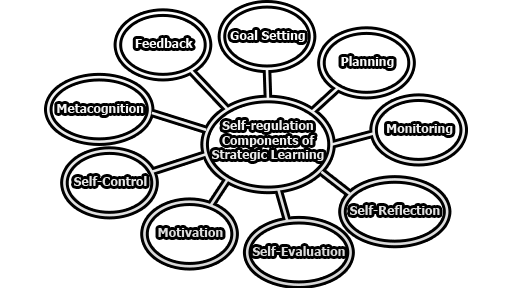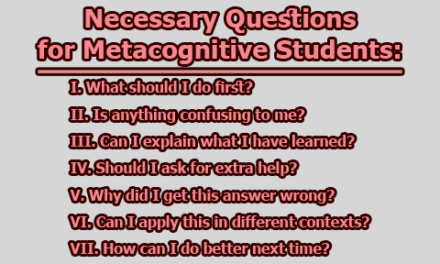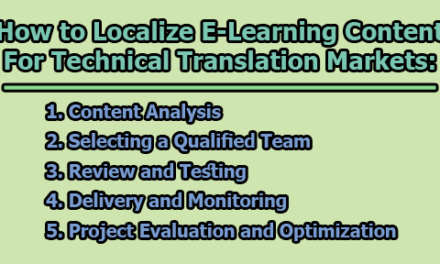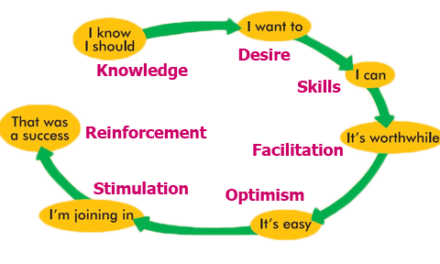Self-regulation Components of Strategic Learning:
Strategic learning involves the use of different cognitive, metacognitive, and motivational strategies to achieve learning goals. Self-regulated learning is a subset of strategic learning, which focuses on learners’ ability to monitor and regulate their learning process. Self-regulation is essential for successful learning outcomes and involves the use of different components. In this article, we will discuss in detail the different self-regulation components of strategic learning.
- Goal Setting: Goal setting is the first component of self-regulated learning. It involves the identification of specific learning goals and the development of a plan to achieve those goals. Goal setting is critical in guiding learners’ behavior, motivating them to engage in learning activities, and helping them monitor their progress. Goals can be short-term or long-term, and they should be challenging yet attainable. The following are examples of how goal setting can be used in different learning situations:
- A high school student may set a short-term goal of improving their math grades by 10% by the end of the semester. They can achieve this goal by developing a study plan, attending extra help sessions, and practicing math problems regularly.
- A college student may set a long-term goal of completing their degree in four years with a high GPA. They can achieve this goal by developing a semester-by-semester plan, balancing their workload, and seeking support when needed.
- Planning: Planning is the second component of self-regulated learning. It involves the development of a detailed plan of action to achieve the identified goals. Planning includes the identification of the necessary resources, such as time, materials, and skills, and the allocation of those resources to specific learning activities. Planning helps learners to stay organized, manage their time effectively, and avoid distractions. The following are examples of how planning can be used in different learning situations:
- An elementary school student may plan their daily homework schedule to ensure they have enough time to complete their assignments, study for tests, and participate in extracurricular activities.
- A language learner may plan their language study sessions by setting specific goals for each session, selecting appropriate materials, and practicing their language skills regularly.
- Monitoring: Monitoring is the third component of self-regulated learning. It involves the continuous evaluation of learning progress to determine if goals are being achieved. Monitoring helps learners to identify areas of weakness and make adjustments to their learning strategies. Monitoring can be done through self-assessment, peer assessment, or teacher assessment. The following are examples of how monitoring can be used in different learning situations:
- A middle school student may monitor their reading comprehension skills by regularly taking practice tests and evaluating their progress against their learning goals.
- A university student may monitor their research progress by keeping track of their sources, taking notes, and assessing their progress against their research objectives.
- Self-Reflection: Self-reflection is the fourth component of self-regulated learning. It involves the critical analysis of learning experiences to identify strengths, weaknesses, and areas for improvement. Self-reflection helps learners to develop a deeper understanding of their learning processes, identify effective strategies, and make adjustments to improve their learning outcomes. The following are examples of how self-reflection can be used in different learning situations:
- An art student may reflect on their artwork to identify areas where they could improve their techniques, such as color blending or brush strokes.
- A science student may reflect on their lab experiments to identify areas where they could improve their understanding of scientific concepts or research methods.
- Self-Evaluation: Self-evaluation is the fifth component of self-regulated learning. It involves the use of feedback and assessment to evaluate one’s learning outcomes. Self-evaluation helps learners to determine the effectiveness of their learning strategies and make adjustments to improve their learning outcomes. Self-evaluation can be done through self-assessment or peer assessment. The following are examples of how self-evaluation can be used in different learning situations:
- A music student may use self-evaluation to assess their performance during a recital, identifying areas where they excelled and areas where they need to improve their technique or interpretation.
- An engineering student may use self-evaluation to assess their design project, identifying areas where they met their objectives and areas where they need to improve their design or testing methods.
- Motivation: Motivation is the sixth component of self-regulated learning. It involves the drive and energy to engage in learning activities and persist in the face of challenges. Motivation can be intrinsic, driven by personal interest or extrinsic, driven by external rewards such as grades or recognition. Motivation plays a critical role in learners’ ability to regulate their learning processes, maintain focus, and achieve their learning goals. The following are examples of how motivation can be used in different learning situations:
- A language learner may be motivated by their personal interest in the language or the desire to travel to a country where the language is spoken.
- An athlete may be motivated by the desire to win competitions or achieve personal bests.
- Self-Control: Self-control is the seventh component of self-regulated learning. It involves the ability to manage one’s emotions, impulses, and behavior to achieve learning goals. Self-control is essential for learners to stay focused, avoid distractions, and resist temptations that may hinder their learning progress. The following are examples of how self-control can be used in different learning situations:
- A student preparing for an exam may use self-control to resist the temptation to check social media or other distractions and instead focus on studying.
- A student may use self-control to regulate their emotions when faced with a challenging assignment or test, avoiding feelings of anxiety or frustration that may interfere with their learning.
- Metacognition: Metacognition is the eighth component of self-regulated learning. It involves the ability to think about one’s thinking, including knowledge of one’s cognitive processes, abilities, and limitations. Metacognition helps learners to develop an awareness of their own learning processes, identify effective learning strategies, and make adjustments to improve their learning outcomes. The following are examples of how metacognition can be used in different learning situations:
- A student may use metacognition to reflect on their reading strategies, identifying which strategies are effective and which ones need improvement.
- A student may use metacognition to reflect on their test-taking strategies, identifying areas where they need to improve their understanding of test formats and methods.
- Feedback: Feedback is the ninth component of self-regulated learning. It involves the provision of information about one’s learning progress, performance, and outcomes. Feedback helps learners to identify areas of strength and weakness, make adjustments to their learning strategies, and improve their learning outcomes. The following are examples of how feedback can be used in different learning situations:
- A writing student may receive feedback from a peer or teacher on their writing style, structure, and grammar, helping them identify areas where they need to improve their writing skills.
- A math student may receive feedback on their problem-solving strategies, helping them identify areas where they need to improve their understanding of mathematical concepts and methods.
At last, we can say that Self-regulated learning is critical for successful learning outcomes. The different self-regulation components of strategic learning, including goal setting, planning, monitoring, self-reflection, self-evaluation, motivation, self-control, metacognition, and feedback, are all essential for learners to develop the ability to monitor and regulate their learning processes. By using these components, learners can become more effective learners and achieve their learning goals. It is important for educators to teach these self-regulation components to their students and provide opportunities for practice and feedback. Furthermore, learners should be encouraged to take responsibility for their own learning and develop a growth mindset that values effort, persistence, and resilience in the face of challenges. Ultimately, the development of self-regulated learning skills is essential for learners to become successful, lifelong learners.
References:
- Zimmerman, B. J. (2008). Investigating self-regulation and motivation: Historical background, methodological developments, and future prospects. American Educational Research Journal, 45(1), 166-183.
- Pintrich, P. R. (2004). A conceptual framework for assessing motivation and self-regulated learning in college students. Educational Psychology Review, 16(4), 385-407.
- Boekaerts, M., Pintrich, P. R., & Zeidner, M. (Eds.). (2000). Handbook of self-regulation. Academic Press.
- Schunk, D. H., & Zimmerman, B. J. (Eds.). (2012). Handbook of self-regulation of learning and performance. Routledge.
- Greene, J. A., & Azevedo, R. (2007). A theoretical review of Winne and Hadwin’s model of self-regulated learning: New perspectives and directions. Review of Educational Research, 77(3), 334-372.
- Dignath, C., Buettner, G., & Langfeldt, H. P. (2008). How can primary school students learn self-regulated learning strategies most effectively? A meta-analysis on self-regulation training programs. Educational Research Review, 3(2), 101-129.
- Boekaerts, M. (1999). Self-regulated learning: Where we are today. International Journal of Educational Research, 31(6), 445-457.
- Efklides, A. (2011). Interactions of metacognition with motivation and affect in self-regulated learning: The MASRL model. Educational Psychologist, 46(1), 6-25.
- Wolters, C. A. (2011). Regulation of motivation: Evaluating an underemphasized aspect of self-regulated learning. Educational Psychologist, 46(4), 267-279.
- Zimmerman, B. J. (2013). From cognitive modeling to self-regulation: A social cognitive career path. Educational Psychologist, 48(3), 135-147.

Assistant Teacher at Zinzira Pir Mohammad Pilot School and College










